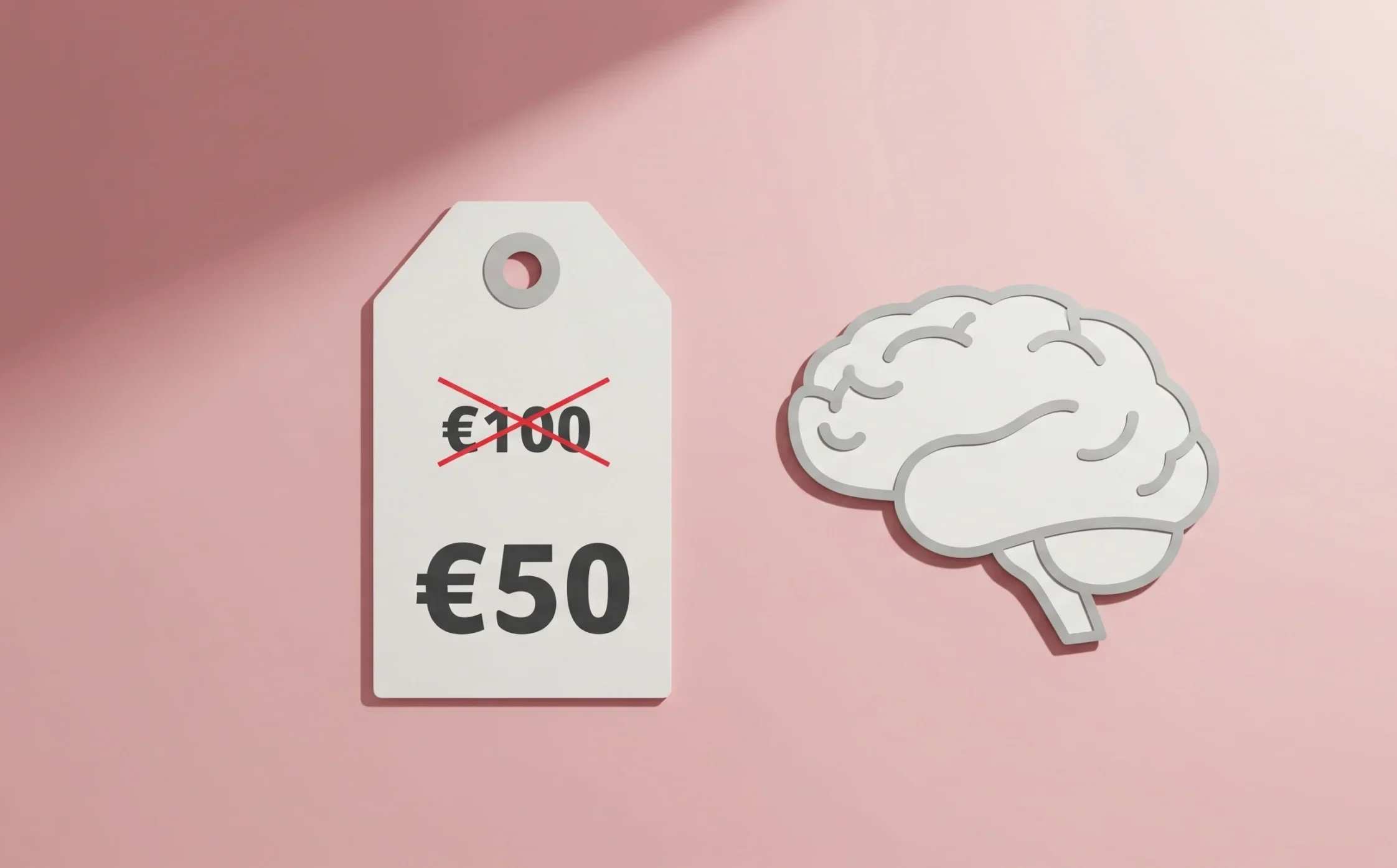The Psychology of Discounts: Boost Sales & Customer Loyalty
It’s a tale as old as commerce itself. A customer, with no intention of buying, sees a bright red “50% OFF” sign. Suddenly, their resolve crumbles. They walk out with a product they didn’t know they needed, feeling not buyer’s remorse, but a sense of accomplishment. They didn’t just buy something; they won.
This isn’t an accident. It’s psychology in action. In fact a whopping 93% of US consumers consider discounts to be a smart move and a crucial factor influencing their purchase decisions.
Discounts are far more than a simple reduction in price. They are powerful psychological triggers that tap into deep-seated human behaviors around value, urgency, and decision-making. The competitor article scratched the surface by mentioning concepts like FOMO and anchoring. But to truly leverage discounts for sustainable growth, you need to go deeper.
This guide will unpack the core psychological principles that make discounts so irresistible. More importantly, it will provide you with actionable strategies to implement them effectively—and warn you about the hidden dangers that can devalue your brand if you’re not careful.
The “Why”: The Irresistible Psychology of a Good Deal
To use discounts effectively, you first have to understand why they work so well. It’s not just about saving money; it’s about how the offer is framed and the emotional response it creates.
The Anchoring Effect: The Power of the Original Price
This is the most common tactic you see: ~~$100~~ $50. The original price, now crossed out, isn’t just a piece of deleted information; it becomes a cognitive “anchor.” Our brains latch onto that initial number as the benchmark for the product’s value. Every subsequent assessment is made in relation to that anchor.
When the new, lower price is presented, the perceived gap between the anchor ($100) and the actual cost ($50) creates a powerful sense of value. The customer isn’t just paying $50; they are saving $50. This reframing from a cost to a gain is a cornerstone of conversion.
The Joy of a “Smart” Decision: Making Customers Feel Like Winners
Nobody likes to feel foolish. Conversely, everyone loves to feel smart. A significant portion of shoppers—as the competitor noted, a very high percentage—view finding a discount as a sign of their own savvy. They outsmarted the system, secured a deal others might miss, and maximized their resources.
By offering a discount, you aren’t just selling a product; you are validating your customer’s intelligence. This positive emotional feedback loop strengthens their connection to your brand and makes them more likely to return, hunting for that next “smart” decision.
Scarcity and FOMO: The Urgency to Act Now
The “Fear of Missing Out” (FOMO) is a potent motivator. Our brains are wired to place a higher value on things that are scarce or limited. When an offer is framed with a time limit (“Sale ends Friday!”) or a quantity limit (“Only 3 left in stock!”), it triggers this scarcity principle.
This creates a sense of urgency that short-circuits the typical, lengthy decision-making process. The customer’s focus shifts from “Do I really need this?” to “If I don’t buy this now, I’ll lose this opportunity forever.” This manufactured anxiety is often just the push a hesitant buyer needs to commit.
The Principle of Reciprocity: A Discount as a “Gift”
When someone gives you a gift, you feel a subconscious urge to give something back. In business, a surprise discount can feel like a gift. Think of the email that lands in your inbox: “Here’s a 15% Off Coupon, Just for You.”
This act of “giving” triggers the reciprocity principle. The customer feels a sense of goodwill towards your brand and is psychologically primed to “return the favor” by making a purchase. This is especially effective for nurturing repeat business and reactivating dormant customers.
Smart Discounting in Action: Strategies That Actually Work
Understanding the psychology is half the battle. Now let’s translate that knowledge into concrete, profit-driving strategies that go beyond the basics.
Percentage-Based vs. Fixed Amount: Applying the Rule of 100
Which sounds better: “20% off a $40 shirt” or “$8 off a $40 shirt”? Most people would say 20% off. Now, which sounds better: “20% off a $1,200 laptop” or “$240 off a $1,200 laptop”? Most would choose $240 off.
This is the Rule of 100.
- For products under $100: A percentage discount (20%) feels psychologically larger and more significant.
- For products over $100: A fixed-amount discount ($240) feels more substantial and impactful.
Use this simple rule to frame your offers for maximum psychological appeal.
Tiered Discounts and Bundles: Encouraging Larger Orders
A single discount can secure a sale. A tiered discount can increase your Average Order Value (AOV). Instead of a flat 10% off, structure your offer to reward bigger purchases:
- Save 10% on orders over $50
- Save 15% on orders over $75
- Save 20% on orders over $100
This gamifies the shopping experience, encouraging customers to add one more item to their cart to reach the next savings tier. Similarly, bundling—grouping related products together for a discounted price (e.g., “Buy a camera and get 50% off the memory card”)—not only increases AOV but also introduces customers to other products they might not have considered.
Internal Linking Idea: Link to a future blog post titled “5 Proven Ways to Increase Your Average Order Value.”
Segmented Offers: The Power of Personalization
A one-size-fits-all discount is good. A personalized discount is great. Modern marketing tools allow you to segment your audience and deliver hyper-relevant offers. Instead of blasting your entire email list, consider creating targeted campaigns:
- For New Customers: A “Welcome” discount (e.g., 15% off your first order) to overcome initial hesitation.
- For High-Value Customers: An exclusive, unadvertised “VIP” discount to reward their loyalty and make them feel special.
- For Cart Abandoners: An automated email offering a small discount (e.g., 10% or free shipping) to entice them back to complete their purchase.
- For Inactive Customers: A “We Miss You!” offer to reactivate their interest.
Personalization makes the customer feel seen and valued, transforming a simple transaction into a relationship.
The Hidden Dangers: When Discounts Can Hurt Your Business
Discounts are a powerful tool, but like any tool, they can cause damage if used incorrectly. A strategy built solely on constant price cuts is a race to the bottom.
Brand Devaluation and Perceived Quality
If your products are always on sale, what does that say about their true value? Constant discounting can train customers to believe the sale price is the real price. This erodes your brand’s perceived quality and premium status. Luxury brands rarely, if ever, run sales for this very reason. Their value is tied to exclusivity and prestige, not bargain-hunting.
Mitigation: Frame your discounts around specific events (holidays, anniversaries, seasonal clearances) rather than making them a perpetual state of business. This gives a legitimate reason for the price drop without devaluing the product itself.
The Vicious Cycle of Customer Expectation
Once you start offering regular discounts, it’s hard to stop. Your customers may become conditioned to wait for a sale before making a purchase. This can destroy your profit margins and create huge, unpredictable swings in revenue, with sales concentrated entirely during promotion periods.
Mitigation: Mix up your offers. Instead of just percentage-off sales, try “Buy One, Get One,” free shipping, or a free gift with purchase. This keeps your promotional strategy fresh and prevents customers from anchoring to a single type of discount.
The Bottom Line: From Tactic to Strategy
Discounts are not a business strategy in and of themselves. They are a tactic within a larger strategy. To use them successfully, you must be intentional.
- Define Your Goal: Are you trying to acquire new customers, increase order value, clear out old inventory, or reward loyal fans? Your goal determines the right type of discount.
- Know Your Numbers: Before offering any discount, calculate your profit margins. A 50% off sale that makes you lose money on every transaction is not a win.
- Communicate with Purpose: Always give a reason for the discount. “End of Season Sale,” “Customer Appreciation Week,” or “Black Friday Special” all provide context and urgency without signaling that your regular prices are inflated.
By understanding the deep psychology behind why we love a good deal, you can move beyond simple price-slashing. You can craft intelligent, targeted offers that not only drive immediate sales but also build customer loyalty, enhance your brand’s perception, and pave the way for sustainable, profitable growth.


